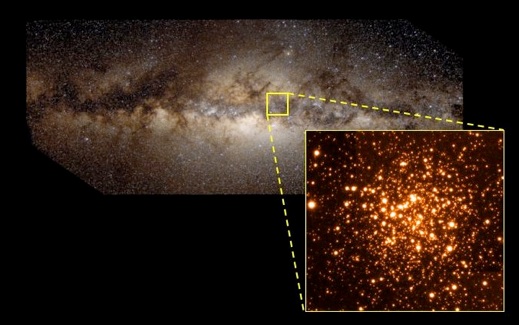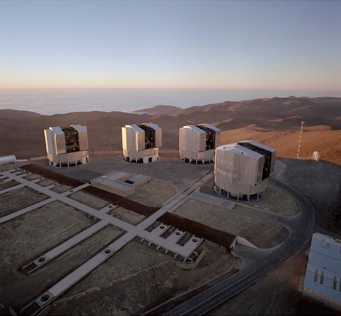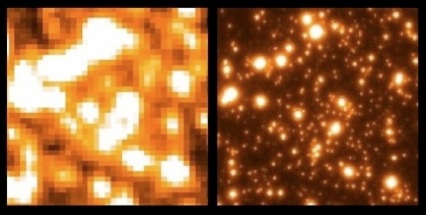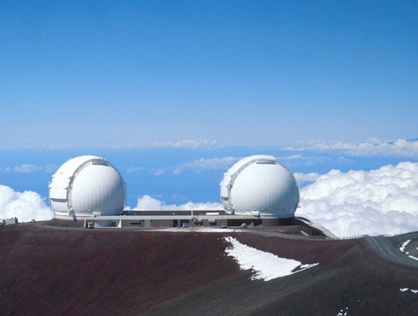A COSMIC “DIG” REVEALS VESTIGES OF THE
MILKY WAY’S BUILDING BLOCKS
Peering through the thick dust clouds of our galaxy’s central part (the “bulge”), a team of astronomers has discovered an unusual mix of stars in the stellar grouping known as Terzan 5. Never observed anywhere in the bulge before, this peculiar “cocktail” of stars suggests that Terzan 5 is one of the bulge’s primordial building blocks, most likely the relic of a proto-galaxy that merged with the Milky Way during its very early days. This is the fascinating conclusion reached by the international team of astrophysics leaded by Francesco Ferraro of the Astronomy Department of the Bologna University and published in the November 26, 2009 issue of the prestigious journal Nature.
The exceptional image of Terzan 5 was obtained with a technical jewel named MAD (Multi-conjugate Adaptive Optics Demonstrator), a cutting-edge instrument that allows the VLT to achieve superbly detailed images in the infrared. Adaptive optics is a technique through which astronomers can overcome the blurring that the Earth’s turbulent atmosphere inflicts on astronomical images obtained from ground-based telescopes. MAD is a prototype of even more powerful, next-generation adaptive optics instruments.
MAD is able to compensate for the degradation effects of the Earth atmosphere, thus making the images comparable in sharpness with those of the Hubble Space Telescope at infrared wavelengths, with a big additional advantage: while Hubble is a 2 m telescope (thus suffering from some of the same limitations affecting a 2 m telescope on the Earth), MAD is mounted on a 8m telescope, the VLT. Indeed, our observations show that adaptive optics systems mounted on ground-based 8m telescopes can provide space-like clarity images, with the additional advantage of a much larger collecting area. In fact this is not the first time that Terzan 5 is observed in the infrared and it was observed also with the Hubble Space Telescope. However the existence of multiple stellar populations was never detected before. “It is only thanks to the outstanding instruments mounted on ESO’s Very Large Telescope,” comments Alessio Mucciarelli (UniBO), “that we have finally been able to ‘disperse the fog’ and gain a new perspective on the origin of the galactic bulge itself”.
The two 10-meter telescopes of the Keck Observatory at the top of the Mauna Kea at the Hawaii islands (USA).
Zooming in onto Terzan 5. This video zooms in onto the cluster, starting from a wide view of the central parts of our home galaxy, and finishing with the amazing near-infrared image obtained with the Multi-conjugate Adaptive Optics Demonstrator (MAD) instrument on ESO’s Very Large Telescope.
Credit:ESO/S.Guisard/Digitized Sky Survey 2/F.Ferraro
The extraordinary image of Terzan 5 in the K band obtained by MAD at the Very Large Telescope (VLT).
The four ESO-VLT 8.2 meter telescopes on top of Cerro Paranal in the Atacama desert (Chile).
The galactic Bulge is the most inaccessible region of our Galaxy, since thick clouds of dust prevent optical light from emerging. Indeed, only infrared radiation can travel across these clouds and bring us direct information on the stars populating this region of the Galaxy. Terzan 5 is a globular cluster-like stellar system orbiting the Bulge at a distance of 20.000 light years from the Earth.
This figure shows two images of the central region of Terzan 5 taken in the infrared with two different ground based telescopes: the image on the left has been obtained with the ESO 3.6 m - New Technology Telescope (NTT), while the image on the right has been obtained with MAD at the VLT. In the latter case, the angular dimension of each stellar image is only 0.1 arcsec and it is constant within the entire field of view. This is really an impressive result for a ground-based telescope.
“Like archaeologists, who dig through the dust piling up on top of the remains from past civilizations and unearth crucial pieces of the history of mankind, we have been gazing through the thick layers of interstellar dust obscuring the bulge of the Milky Way and have unveiled an extraordinary cosmic relic” says Francesco Ferraro of the Astronomy Department of the Bologna University (UniBO), leader of the team that made the discovery. “As a relic, we have to study it in detail because in fragments like this, it is written the history of the formation of the first cosmic structures (as the Galaxy) at the time when the Universe was a “baby”, just one-billion year old.”
The target of the study is the star cluster Terzan 5, a stellar system which has been catalogued as a globular cluster since 1968 when it was discovered by the French astronomer Agop Terzan. The new observations show that this object, unlike most globular clusters, does not harbor stars which are all born at the same time — what astronomers call a “single population” of stars. Instead, stars in Terzan 5 have formed in at least two different epochs, the earliest probably some 12 billion years ago and then again 6 billion years ago.
“The discovery was made in two steps: first, by using a set of extraordinarly sharp infrared images (obtained with the ESO Very Large Telescope), we discovered that two groups of stars
The discovery of a multiple population with different iron content in Terzan 5 opens a new perspective on the origin of this stellar aggregate, suggesting that it could be the remnant of one of the primordial building-blocks of the Galactic bulge. A popular model for the formation of the Mily Way bulge (as well as of elliptical galaxies and spiral bulges) is the so-called "monolithic collapse", according to which these structures formed all at once from a single collapsing cloud. “Instead, our discovery now shows that individual "complex" stellar systems are harbored into the bulge, with the same bulge chemical composition; hence the bulge could have formed by the aggregation of individual pre-formed and somewhat internally evolved stellar systems.” concludes Ferraro.

For additional information please contact:
email: francesco.ferraro3@unibo.it
Tel: +39 051 2095774
Cell: +39 338 8941576

with different properties (in terms of temperature and luminosity) were harbored by Terzan 5” adds team member Barbara Lanzoni (UniBO). “Then we immediately measured the chemical composition of these two groups (by using the Keck Telescope in the USA) and we discovered that they also have a different iron content” adds R. Michael Rich from University of California Los Angeles. This was just amasing and confirmed that the two stellar populations have had different formation history and age: in fact as expected from the “canonical” evolution, the younger population has formed from a metal-enriched gas, polluted by the supernovae explosions of the first stellar population”.
Indeed, in order to retain enough supernova ejecta and form a second generation of iron-enriched stars, this system should have been much more massive in the past than what we observe today. From these considerations an exciting scenario is emerging: Terzan 5 could be the relic of a massive proto-galaxy, one of the primordial building blocks of the Galactic Bulge.
“Only one globular cluster with such a complex history of star formation has been observed in the halo of the Milky Way: Omega Centauri. This is the first time we see this in the bulge” says team member Emanuele Dalessandro. Moreover, the dominant stellar population in Omega Centauri is quite metal poor (a few cents of the solar metallicity) and this object could therefore be the remnant of a stellar system that was accreted by the Galaxy during its evolution. Instead, in the case of Terzan 5, the scenario seems to be quite different, since the oldest stellar population has the same metallicity (half solar) of the stars in the Bulge. This suggests that the entire Bulge could be formed by the progressive disruption of many Terzan5-like objects.








